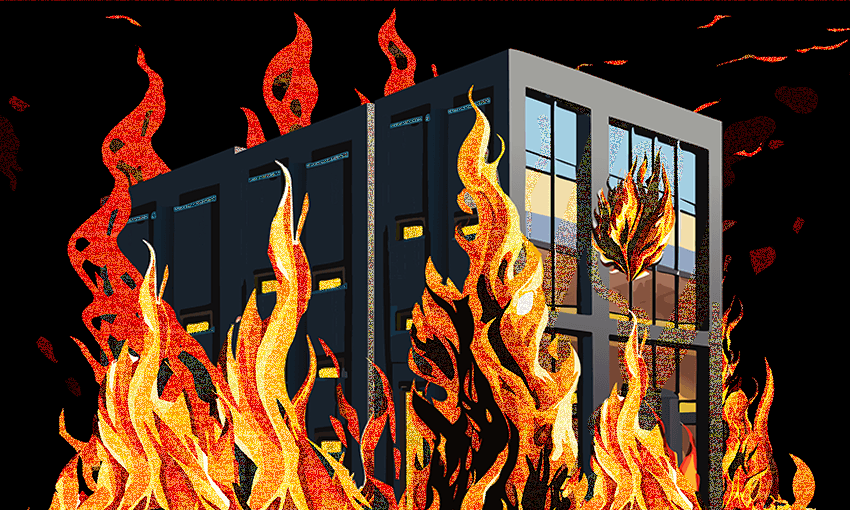In some ways, I couldn’t have been closer to the tragedy. In others, I was a whole universe away.
This essay was first published on 3 March, 2024. The Sunday Essay is made possible thanks to the support of Creative New Zealand.
Had you been trying to market a suburb in Wellington, the Loafers Lodge was not the sort of landmark you’d want to draw attention to. Four storeys tall and infinitely bleak, the building stands on a busy corner between John Street and Adelaide Road. It’s a newly hip area, across from a homeware shop where I once spent $59 on a candle and a coffee shop that sells vegan doughnuts on Fridays. The Snickers one is my favourite. When I was a kid, the building was white with a blue trim, as though someone had captured the sky and turned it inside out. In most of my memories, the building is the colour it is now: a despairing brown, like a malt drink made with powdered milk that expired in 2019, alongside hopes of a capital gains tax.
From my apartment, I have a view of the left side of the building, which has been largely walled over. For years it has hosted a giant billboard. As with so much of Wellington’s prime real estate, this billboard had been capitalised on by Lowe & Co. For a while the company displayed a sign that said, “We can see your next house from here.” Then they replaced that with, “We’re not going, are you?” That one was for a City Mission fundraiser, in which you could buy tickets to an event you didn’t attend, with all the proceeds providing essentials for people who were struggling. It was a good premise, a clever campaign too, but what I really got a kick out of were the layers of irony. Lowe & Co was fundraising for people in need, on a building filled with people in need, in a city that was becoming – with their help – increasingly unaffordable. “And it’s for an event they literally don’t have to show up to,” I moaned to workmates, “I mean, that’s the extent of their community engagement: staying in their own homes.”
From the road, I could see through the Lodge’s grimy narrow windows and into its rooms, and I could also see its signs. There were three, in a mix of fonts, sizes and colours, offering, in turn, ‘ACCOMMODATION,’ ‘Superior Rooms,’ and an illustration of loafers, outlined in a thick black paint and covered in white polka dots. I always felt that there was a slight ambiguity about what the pun meant. Was it a lodge named after, or perhaps for, shoes? Or the people who lived there?
While its website marketed the Lodge as an affordable and convenient option for short-term stays in Wellington, it didn’t really cater to travellers. Most of the residents were – for one reason or another, and often for many reasons – vulnerable. By and large, they were not the sort of subjects that make for sympathetic news stories. Folks with significant mental health and substance abuse issues, people with criminal records, criminal deportees too, packaged up in legal jargon and sent back here from Australia to become someone else’s problem. I didn’t know a single one of them, and I didn’t try to get to know them. Instead, morning and evening, I smiled vaguely as I passed them by, on my way to better things.
Although it wasn’t clear from the outside just how bad the building’s condition was, I could hazard a guess that it wasn’t great. One reason is that I work in housing policy, and so have some background on New Zealand’s housing deficit, the length of our emergency housing waitlists, the quality of our rental stock. The other and more pertinent reason is that I have eyes. Irrespective of the angle from which you viewed the lodge, the place looked grungy.
While the building had been refurbished since its previous life as a house of the Lord, it wasn’t the kind of sexy church conversion that makes it into the glossy pages of a House & Garden magazine. There were no stained-glass windows to preserve or brick walls to reveal. There were no vaulted ceilings to add grandeur and monumentality, or to protect the inside of the building should the roof catch on fire.
As a bureaucrat, though, my job is to analyse and advise, not to advocate. In this case, my analysis and advice was clear: boarding houses fill a gap in the market for people who, without systemic change, would otherwise be homeless.
It was this job in housing policy that I called in sick to when I awoke one Tuesday morning with a headache, sore throat and blocked nose. I’d slept, as I often do, with the windows open, and so I should have realised what was happening. Somehow, it wasn’t until I logged onto the Herald that I found out that the Lodge had gone up in flames.
Living so near the hospital, I think I must have become desensitised to the sound of tragedy. I either no longer register the blare of sirens, or if I do, I register it like any other background noise. The drip from a tap, the tick of a clock, the sound of someone dying: all the same to me, especially at night, which was when the fire began.
Initial reports indicated that people had likely died, but it took a while to confirm how many, and even longer to confirm who they had once been. To remove the bodies, five in total, police cordoned off a large stretch of Adelaide Road and redirected traffic. While the operation was underway, my workmates and I complained about the commute time. We were already contending with Wellington’s bustastrophe, and now this?
“I drove into work today,” my boss said one morning, throwing her bags onto a desk.
“Are you planning on Venmoing the Council for all that you’ve spent on parking and Ubers?” I joked, swivelling in my chair to face her.
It was Wellington City Council that had been advised, and failed, to conduct annual checks on buildings like Loafers Lodge. Over the past decade, the place had only had two on-site inspections, and the most recent one in 2018 found fire risks. These were the sorts of details released by the Herald, Stuff and RNZ over the coming weeks. We found out that, while the building had fire alarms, they regularly went off, so were ignored by many residents. No sprinklers had been installed, because they weren’t a regulatory requirement for buildings of that height. The front door had been kicked in by ex-tenants, and while it was usable, it was broken, with a sign directing people to the side entrance.
Once the smoke clouds began to dissipate, it became obvious the top floor of the Lodge had received the worst damage from the blaze. Black soot poured from the windows and clung to the side of the building, so thick it looked like ink. A bunch of window panes had been broken; by the heat, by the hands of desperate people trying to get out. At the advice of the fire department, I kept my own windows closed for the duration of the clean-up, because in addition to bed bugs, the building was also filled with asbestos, particles of which must now be in the lungs of the survivors.
While it was still an abstraction, I referred to the case – through allusion rather than outright – in meetings, as an example of why we needed better and more affordable housing options. I had done the victims no justice when they were alive, and in this way, I felt as though I could do them some justice in death. Now I realise how flawed, and moreover, how insulting my logic was. I turned each of the five men, and all of their neighbours, into a political rallying cry, as is so easy to do with people on the margins. Even if we had reached some kind of an end, those people were not a means to achieving it.
As the bodies were identified, stories about each person flooded my personalised news feed, all of the men reduced to bite-sized chunks, big enough to grab the headlines but small enough to fit on the screen of my phone. I recognised two, but did not know either of them. Nor did I know the others, my neighbours from whom the fire took not just every personal effect they owned, but also their community. Just a kilometre away from one another, we inhabited very, very different worlds.
It was after the fire, when I began to care about the building, that I learned it was once a Pentecostal church. Pentecostals believe that when someone dies, they will spend an eternity in heaven or hell, depending on whether or not they have been saved. Baptism is an important part of being saved, symbolising the death of the old, sinful life and birth of the new life in which Jesus is accepted as Lord and Saviour.
Across the branches of Christianity, baptism is practised in different ways, including through aspersion (sprinkling water over the head) and affusion (pouring water over the head). Pentecostals typically practise immersion baptism because, according to the World Mission Society Church of God website, “When burying a dead body, it is not enough to just sprinkle a shovelful of dirt over it once or twice.” This view is consistent with the doctrine more broadly, which holds that faith cannot be found through ritual or thinking, but must be powerfully experienced through the human body, a temple of the Holy Spirit.
It took only five minutes for firefighters to arrive at the Lodge in trucks carrying hundreds of gallons of water. By that point, though, the place was well on its way to being uninhabitable – or perhaps, more uninhabitable than it had always been. Throughout the night and into the next day, almost 90 firefighters from 33 trucks battled the blaze. The truck carrying a 32-metre ladder was out of order, under maintenance. According to some reports, it had been out of order for more than 400 days. While firefighters awaited a back-up truck, they used the standard 17-metre ladders to battle the “nightmare scenario,” as one fire chief put it.
Nearby cafés, including the one that sells the Snickers doughnuts I like, encouraged patrons to support the fire and police services. Those services did, by all accounts, an excellent job. They were not just contending, though, with the work of a 48-year-old arsonist. They were contending with years of policy and regulation that had in effect doused the place in gasoline.
While the Lodge no longer exists, the building itself is still standing, and I continue to walk by it, morning and evening, on my way to work. In the immediate aftermath of the fire, the bus-stop across the road was filled with flowers, cards, and pictures of the victims. For a time, a few former Lodge residents kept vigil. They may have been the same residents who alerted their neighbours to the blaze, calling for them and knocking on their doors, before running or crawling or jumping to safety.
There is a security fence around the first floor of the building now. At some point, I assume the whole place will be demolished. There are no set plans for the site, as far as I know, although I imagine its size and location will so appeal to developers that it will sell itself. While Lowe & Co have taken the billboard down, it remained up there for so long, still easily visible from my apartment.
“A round of silent applause,” it read.

